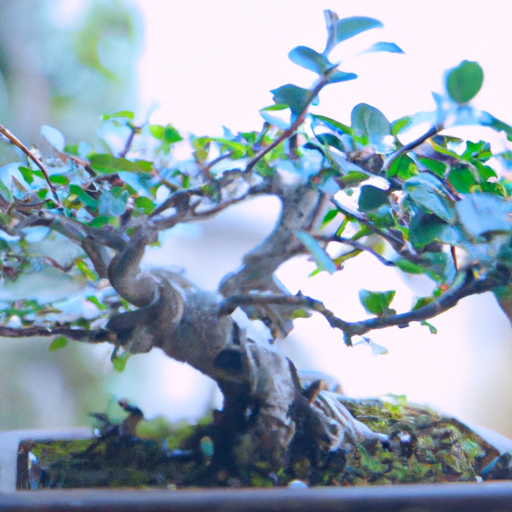Table of Contents
How to Care for a Rain Tree Bonsai

Caring for a Rain Tree Bonsai is a rewarding experience that can bring you years of enjoyment. Here are some tips to help you get started:
1. Location: Rain Tree Bonsai should be placed in a spot that gets plenty of indirect sunlight. Avoid direct sunlight, as this can cause the leaves to burn.
2. Watering: Rain Tree Bonsai should be watered regularly, but not too often. Allow the soil to dry out between waterings.
3. Fertilizing: Fertilize your Rain Tree Bonsai every two weeks during the growing season with a balanced fertilizer.
4. Pruning: Prune your Rain Tree Bonsai regularly to maintain its shape and size. Use sharp pruning shears and make sure to remove any dead or diseased branches.
5. Repotting: Repot your Rain Tree Bonsai every two to three years. Use a well-draining soil mix and make sure to provide adequate drainage.
With proper care and attention, your Rain Tree Bonsai will thrive and bring you years of enjoyment.
The History and Origins of the Rain Tree Bonsai
The Rain Tree Bonsai is a unique and beautiful type of bonsai tree that has been around for centuries. It is native to tropical and subtropical regions of the world, and is known for its distinctive umbrella-like canopy of leaves. The Rain Tree Bonsai is a popular choice for bonsai enthusiasts, as it is relatively easy to care for and can be trained to create a variety of shapes and styles.
The Rain Tree Bonsai is believed to have originated in India, where it was first cultivated by Buddhist monks. The monks used the Rain Tree Bonsai to create intricate designs and patterns in their gardens. Over time, the Rain Tree Bonsai spread to other parts of Asia, and eventually to Europe and the Americas.
The Rain Tree Bonsai is a member of the Fabaceae family, which includes other popular bonsai trees such as the Ficus and the Juniper. It is a deciduous tree, meaning that it loses its leaves in the winter and grows new ones in the spring. The Rain Tree Bonsai is also known for its ability to tolerate a wide range of temperatures and climates, making it an ideal choice for bonsai enthusiasts who live in different parts of the world.
The Rain Tree Bonsai is a popular choice for bonsai enthusiasts because of its unique shape and size. It can be trained to create a variety of shapes and styles, from a traditional umbrella shape to a more modern, sculpted look. The Rain Tree Bonsai is also known for its ability to tolerate a wide range of temperatures and climates, making it an ideal choice for bonsai enthusiasts who live in different parts of the world.
The Rain Tree Bonsai is a beautiful and unique type of bonsai tree that has been around for centuries. It is native to tropical and subtropical regions of the world, and is known for its distinctive umbrella-like canopy of leaves. The Rain Tree Bonsai is a popular choice for bonsai enthusiasts, as it is relatively easy to care for and can be trained to create a variety of shapes and styles. With its unique shape and size, the Rain Tree Bonsai is sure to add beauty and elegance to any bonsai collection.
The Benefits of Growing a Rain Tree Bonsai
Growing a rain tree bonsai is a rewarding experience that can bring a lot of joy to your life. Not only is it a beautiful addition to your home, but it also offers a number of benefits. Here are some of the advantages of growing a rain tree bonsai:
1. Low Maintenance: Rain tree bonsai are relatively low maintenance compared to other bonsai varieties. They don’t require a lot of pruning or special care, so they’re perfect for those who don’t have a lot of time to devote to their bonsai.
2. Long-Lasting: Rain tree bonsai are known for their longevity. With proper care, they can live for decades, making them a great investment for those who want to enjoy their bonsai for years to come.
3. Easy to Shape: Rain tree bonsai are easy to shape and train. With a little bit of patience and practice, you can create a beautiful bonsai that will be the envy of your friends and family.
4. Versatile: Rain tree bonsai are incredibly versatile. They can be grown indoors or outdoors, and they can be trained to grow in a variety of shapes and sizes.
5. Stress Relief: Taking care of a bonsai can be a great way to relieve stress. The process of pruning and shaping your bonsai can be very calming and therapeutic.
Growing a rain tree bonsai is a great way to add beauty and serenity to your home. With its low maintenance requirements and long-lasting nature, it’s the perfect choice for those who want to enjoy the benefits of bonsai without having to devote a lot of time and energy to it.
Tips for Pruning and Training a Rain Tree Bonsai
Pruning and training a rain tree bonsai is a great way to create a beautiful and unique bonsai. It’s also necessary for the health of your plant. Here are some tips to help you get started:
1. Pruning: Pruning is an important part of bonsai care. Prune your rain tree bonsai regularly to keep it healthy and encourage new growth. Start by removing any dead or damaged branches, then trim back the remaining branches to the desired shape.
2. Training: Training your rain tree bonsai is essential for creating the desired shape. Use wire to shape the branches and trunk into the desired shape. Be sure to check the wire regularly to make sure it isn’t cutting into the tree.
3. Watering: Rain tree bonsais need to be watered regularly. Water your bonsai when the soil is dry to the touch. Be sure to water thoroughly, but don’t over-water.
4. Fertilizing: Fertilize your rain tree bonsai every few weeks with a balanced fertilizer. This will help keep your bonsai healthy and encourage new growth.
5. Repotting: Repot your rain tree bonsai every two to three years. This will help keep the roots healthy and encourage new growth.
Following these tips will help you create a beautiful and unique rain tree bonsai. With regular pruning, training, watering, fertilizing, and repotting, you can create a stunning bonsai that will last for years to come.


